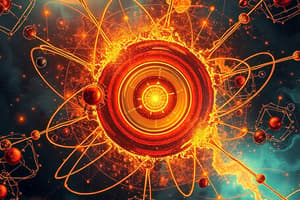Podcast
Questions and Answers
According to the Aufbau Principle, how do electrons fill orbitals?
According to the Aufbau Principle, how do electrons fill orbitals?
- Electrons fill orbitals from the lowest energy level up. (correct)
- Electrons fill orbitals from the highest energy level down.
- Electrons fill orbitals randomly.
- Electrons fill all orbitals of the same energy level before moving to the next energy level.
Isotopes are atoms of different elements that have the same number of protons.
Isotopes are atoms of different elements that have the same number of protons.
False (B)
What are the electrons in the outermost shell of an atom called?
What are the electrons in the outermost shell of an atom called?
Valence electrons
Stable isotopes do not undergo __________.
Stable isotopes do not undergo __________.
Match the following concepts with their definitions:
Match the following concepts with their definitions:
Which of the following is a characteristic of radioactive isotopes?
Which of the following is a characteristic of radioactive isotopes?
The principal quantum number indicates the shape of the orbital.
The principal quantum number indicates the shape of the orbital.
Name one application of radioactive isotopes.
Name one application of radioactive isotopes.
Flashcards are hidden until you start studying
Study Notes
Atomic Structure
Electron Configuration
- Definition: Distribution of electrons in an atom's orbitals.
- Principles:
- Aufbau Principle: Electrons fill orbitals starting from the lowest energy level up.
- Pauli Exclusion Principle: No two electrons in an atom can have the same set of four quantum numbers.
- Hund's Rule: Electrons will fill degenerate orbitals (same energy level) singly before pairing up.
- Notation:
- Represented using the format: e.g., 1s² 2s² 2p⁶.
- Denotes energy level, type of orbital (s, p, d, f), and number of electrons.
- Valence Electrons: Electrons in the outermost shell, important for chemical bonding.
Isotopes
- Definition: Atoms of the same element with the same number of protons but different numbers of neutrons.
- Types:
- Stable Isotopes: Do not undergo radioactive decay (e.g., Carbon-12).
- Radioactive Isotopes: Unstable isotopes that decay over time (e.g., Carbon-14).
- Notation: Often represented as element name or symbol followed by mass number (e.g., Carbon-12 is written as C-12).
- Applications:
- Used in radiocarbon dating, medical diagnostics, and tracing chemical pathways in research.
Quantum Mechanics
- Definition: The branch of physics describing the behavior of matter and energy at atomic and subatomic levels.
- Key Concepts:
- Wave-Particle Duality: Particles exhibit properties of both waves and particles.
- Quantum States: Describes the energy levels of electrons in an atom, quantified in discrete amounts.
- Quantum Numbers:
- Principal Quantum Number (n): Energy level and distance from the nucleus.
- Angular Momentum Quantum Number (l): Shape of the orbital (s, p, d, f).
- Magnetic Quantum Number (mₗ): Orientation of the orbital in space.
- Spin Quantum Number (mₛ): Direction of electron spin (+½ or -½).
- Heisenberg Uncertainty Principle: States that certain pairs of physical properties (like position and momentum) cannot be simultaneously known with precision.
Electron Configuration
- Describes the distribution of electrons in an atom's orbitals
- Follows the Aufbau principle: Electrons fill orbitals in order of increasing energy levels
- Follows the Pauli exclusion principle: No two electrons in an atom can have the same set of four quantum numbers (n, l, mₗ, mₛ)
- Follows Hund's rule: Electrons will individually occupy degenerate orbitals before pairing up
- Represented using a notation that indicates the energy level, type of orbital (s, p, d, f), and the number of electrons (e.g., 1s² 2s² 2p⁶)
- Valence electrons are located in the outermost shell and play key roles in chemical bonding
Isotopes
- Atoms of the same element that have the same number of protons but different numbers of neutrons
- Stable isotopes do not undergo radioactive decay (e.g., Carbon-12)
- Radioactive isotopes are unstable and decay over time (e.g., Carbon-14)
- Often represented as element name or symbol followed by the mass number (e.g., Carbon-12 is written as C-12)
- Have applications in radiocarbon dating, medical diagnostics, and tracing chemical pathways in research
Quantum Mechanics
- Branch of physics that describes the behavior of matter and energy at the atomic and subatomic level
- Key concepts include wave-particle duality: particles exhibit properties of both waves and particles
- Electrons occupy quantized energy states, meaning they can only exist at specific discrete energy levels
- Quantum numbers are used to describe an electron's state:
- Principal quantum number (n)
- Angular momentum quantum number (l)
- Magnetic quantum number (mₗ)
- Spin quantum number (mₛ)
- Heisenberg uncertainty principle states that certain pairs of physical properties (position and momentum) cannot be simultaneously known with precision
Studying That Suits You
Use AI to generate personalized quizzes and flashcards to suit your learning preferences.




